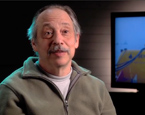4. Searching for the Plume
Almost as soon as the spill began, speculation abounded about the fate of the oil. The slick on the surface was huge and spreading, but wasn’t big enough to account for all the oil gushing out of the broken wellhead. Since the source of the oil was more than a mile below the surface, it was reasonable to think that some—perhaps most—of it remained far below the surface, where it could threaten Gulf fisheries and deep-sea ecosystems.
Evidence for a hydrocarbon plume had been found, but its size, location, and composition remained unknown. Federal agencies, BP, scientists, and the public all needed to know: Was some portion of the oil remaining out of sight? If so, what did it contain and where was it going?
To answer those questions, the National Science Foundadtion funded Chris Reddy, Dana Yoerger, and Rich Camilli, WHOI scientists who had years of experience finding and mapping deep-sea plumes of hydrocarbons.
The researchers fitted the autonomous underwater vehicle Sentry with TETHYS, a backpack-sized underwater mass spectrometer able to detect tiny amounts of chemicals. The team likens the combination to a hound on the trail of elusive quarry; if Sentry is the dog, TETHYS is its nose.
TETHYS inventor Camilli set the instrument to sniff for benzene, toluene, and other components of crude oil. Then the team programmed Sentry to follow a zigzagging path that would take it through the area where they had seen evidence of a plume. Their “hound” found its prey: a plume of hydrocarbons more than 35 kilometers long, 2 kilometers wide, and 200 meters high.
The team took water samples from areas of the plume that Sentry identified. Reddy later analyzed the samples to identify chemicals for comparison with oil from the wellhead.
On the same cruise, chemist Ben Van Mooy measured oxygen levels in and around the plume. The news media had carried dire predictions that vast areas of the Gulf would become “dead zones” because microbes eating the oil were using up so much oxygen that fish and shellfish could not survive. Van Mooy used a 130-year-old method called the Winkler titration, the most reliable technique known, to show that oxygen levels were normal—a rare bit of good news in the midst of the unfolding disaster.
WHOI personnel in this video (in order of appearance):

Stephanie Murphy
Public Information Manager





